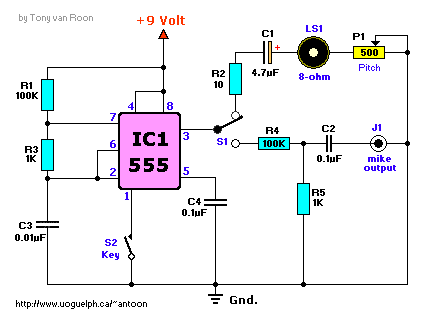Morse Code Keyer (2)

Parts List:
R1,R4 = 100K IC1 = LM555
R2 = 10 ohm S1 = 3-pole, switch toggle, on-on
R3,R5 = 1K S2 = Morse keyer
P1 = 500 ohm J1 = Jack, mike-output
C1 = 4.7uF/16V LS1 = Loudspeaker, 8-ohm, up to 2 watts
C2,C4 = 0.1 uF Batt1 = 9-Volt Alkaline battery
C3 = 0.01uF
Description:
The speaker (LS1) can be any 8-ohm type up to 2-watts. Supply voltage for this circuit is up to 15 volts, but 12V is
more desirable if you choose to go with an adapter. If possible, try to use a mylar or polyester kind of capacitor
for C2.
IC1 is a CMOS MC1455P or equivalent, Timer/Oscillator. This type of cmos IC
consumes a lot less current when used with the 9-volt battery, but if you don't want to spent the money then the
LM555, NE555, etc. are fine too and are pin-for-pin compatible with each other.
The timing circuit is formed by R1, R3, and C3. Resistors R4 & R5 are a voltage divider to reduce the microphone
output to a safe level. Potentiometer P1 can be used to control the 'Pitch'. Capacitor C4 is used as a bypass
capacitor to clean up unwanted noise. C1 is specified as a 5uF electrolytic but a standard 4.7uF will work fine
too.
S2 is your Morse-key or Paddle. S1 switches between your speaker and the microphone output jack (J1), which you
can hookup to your stereo, amplifier, or cassette player. Match J1 with the jack you hook it up to.
Back to Circuits page
Copyright © Tony van Roon

